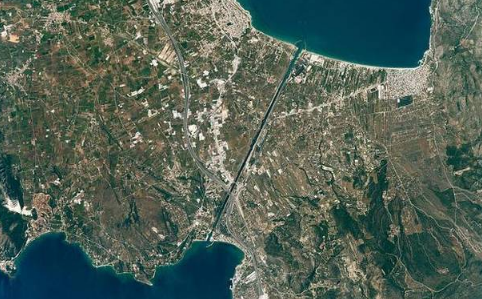The man-made channel has been a critical artery for global trade since 1869
To buy our online courses: Click Here
Read More: The thaw on the India-Pakistan front
The idea of linking the Mediterranean Sea to the Erythraean Sea (today’s Red Sea) had excited both Egypt’s rulers and colonisers from ancient to modern times. Pharaoh Senausret III (1887-1849 BC) built the first canal linking the Erythraean Sea in the south to the Nile river in the north and thereby opening a waterway to the Mediterranean. Pharaoh Nacho II, who died in 595 BC, started building another canal from the Nile to the south. It was Persian Emperor Darius I who completed the canal. Archaeologists have unearthed granite stelae on the banks of the Nile that have inscription from Darius’s time. One such inscription reads: “I am a Persian. Setting out from Persia, I conquered Egypt. I ordered this canal dug from the river called the Nile that flows in Egypt, to the sea that begins in Persia. When the canal had been dug as I ordered, ships went from Egypt through this canal to Persia, even as I intended.” Over the centuries, the canal would be ignored by leaders particularly as navigation becomes impossible due to silt and reopened by some, including Ptolemy II Philadelphus in second century BC. Many geologists believe that the Red Sea receded over the centuries and its coastline moved southward away from the lakes in Suez. This, coupled with persistent accumulations of Nile silt, made it difficult to keep the waterways open. So for centuries, the canal was abandoned by Egypt’s rulers — until the arrival of Napoleon Bonaparte.
Napoleon invaded Egypt in 1798 as part of his global campaign to weaken the British Empire. He wanted to build a canal across Suez under the French control because he thought it would leave a twin blow to the British. One, it would provide the French a quicker and easier access to the Indian Ocean and thereby to Indian Coastline, which was controlled by the British. Two, by opening a new trade route from Europe to Asia, France could hurt the British who controlled the existing route around the Cape of Good Hope. But a miscalculation in the geological study of the region prompted Napoleon to abandon the project. The surveyors erroneously concluded that the Red Sea coast was some 30 feet higher than the Mediterranean coast and that a canal would risk flooding in the Nile Delta.
Napoleon abandoned the project but the idea of the Suez canal outlived the emperor. In the mid-19th century, French diplomat and engineer Ferdinand de Lesseps won permission from Egypt’s Ottoman-appointed ruler Said Pasha to start building the canal. In 1858, Universal Suez Ship Canal Company was formed to execute the project and construction work began a year later. Britain, which controlled the route around the African continent, opposed the project as a new waterway would hurt its interests. But in 1869, the canal was officially opened for traffic. Britain would move from being an adversary of the project to a key beneficiary in six years when the Egyptian government, straddled with financial problems, sold its stake in the canal to London in 1875. Since then, France and Britain operated the canal, until Egypt’s socialist President Gamal Abdel Nasser nationalized it in 1956.
The Suez crisis
On October 29, 1956, three months after Nasser nationalized the canal, Israeli troops attacked the Egyptian Sinai. French and British troops joined in later. The plan was to retake control of the canal and remove Nasser, who was being emboldened by the Soviet support. But the invasion did not go ahead as planned. Soviet leader Nikita Khrushchev threatened Israel, Britain and France with rocket attacks unless they withdrew troops from the Sinai. U.S. President Dwight D. Eisenhower, partly upset that the British went ahead with the invasion without American approval and partly out of strategic concern that the invasion would play into the hands of the Soviet Union, threatened Britain and others with economic sanctions unless they withdrew the troops. By March 1957, the invading troops were fully withdrawn and Egypt’s authority over the canal was recognized. Interestingly, the Suez crisis was the sharpest manifestation of Great Britain’s dwindling influence in West Asia, a region it controlled since the fall of the Ottoman Empire, and the arrival of the U.S. as a new great power in the region. The canal was closed again during the 1967 war. It would be reopened only in 1975 after Egyptian-Israeli relations started warming following the 1973 Yom Kippur War.
Egypt’s President Abdel Fatteh al-Sisi, who came to power through a coup in 2013, launched an ambitious $8.5-billion expansion project at the canal in 2014 as part of which a second line was dug along its northern section, allowing two-way traffic. The canal is an important source of revenue for Egypt’s battered economy. Last year, Egypt generated $5.61 billion in revenues from the canal and the authorities expect this to double by 2023. About 19,000 ships passed through the channel in 2020 carrying 1.2 billion tones of cargo, according to the Suez Canal Authority. As much as 13% of all maritime trade, from oil to automobiles, pass through the canal every year. So a delay in reopening the channel will have a huge impact on export businesses, commodities, ship and cargo companies and even Egypt’s national economy.




